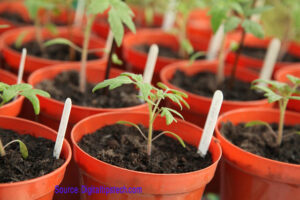Tomato roots grow
How deep do tomato roots grow?, Delving into the world of gardening, one cannot help but marvel at the resilience and adaptability of plants like tomatoes. Understanding the intricacies of their root systems is essential for cultivating thriving crops. In this exploration, we embark on a journey to unearth the mysteries surrounding tomato roots, revealing their hidden depths and shedding light on the factors that influence their growth. Join us as we combine scientific knowledge with a human touch to uncover the secrets beneath the soil.

Anatomy of Tomato Roots
Beneath the green foliage and luscious fruits, the true foundation of a healthy tomato plant lies in its roots. Tomato roots consist of two main types: the primary taproot and the fibrous lateral roots. The primary taproot is responsible for initial penetration into the soil, but it eventually gives way to the fibrous lateral roots, which play a vital role in nutrient absorption and water uptake. These lateral roots branch out horizontally in search of vital resources, forming a dense network that sustains the plant throughout its life.
How Deep Do Tomato Roots Grow?
The depth to which tomato roots grow largely depends on various factors, including the tomato variety, soil type, water availability, and environmental conditions. On average, tomato roots can extend anywhere from 1 to 3 feet deep into the soil. Determinate tomato varieties, which have a fixed growth pattern and typically stop growing at a certain height, may develop shallower root systems. Conversely, indeterminate varieties, which continue to grow throughout the growing season, tend to produce deeper and more extensive root networks.
Factors Influencing Root Growth
Soil Type and Composition:
The type of soil significantly impacts the depth and spread of tomato roots. Loose, well-draining soils promote deeper root growth, allowing the roots to explore the subsoil for nutrients and water. On the other hand, compacted or clayey soils may hinder root penetration, leading to shallower root systems.
Water Availability:
Water is a critical factor in determining root growth. If water is readily available near the surface, tomato roots may not need to grow as deep to access it. However, in dry regions or during drought conditions, tomato plants will extend their roots deeper into the soil in search of moisture.
Temperature and Climate:
Tomatoes thrive in warm climates, and their root growth is influenced by temperature. Warmer temperatures generally stimulate root growth, while cold temperatures may slow it down. This is why tomatoes often produce more robust root systems during the warm growing seasons.

The Role of Human Touch in Tomato Cultivation
Gardening is a beautiful synergy of science and art, where human touch plays a pivotal role. As caretakers of these living organisms, we can encourage optimal root growth through various practices:
Proper Planting Depth:
When transplanting tomato seedlings, ensure they are planted at the right depth to promote healthy root development. Placing them too deep or too shallow can hinder root growth and affect overall plant health.
Mulching:
Applying organic mulch around tomato plants aids in moisture retention, weed suppression, and temperature regulation. This encourages the roots to stay close to the surface, where they can benefit from these favorable conditions.
Watering Techniques:
Water deeply and consistently to encourage deeper root growth. Infrequent, deep watering promotes stronger roots, as opposed to frequent shallow watering that can lead to weaker, surface-level roots.
What types of soil need for tomatoes?
The depth of soil required for growing tomatoes depends on several factors, including the type of tomato plant, the local climate, and the root system of the tomato variety being grown. In general, tomato plants have a relatively extensive root system, and providing adequate soil depth is essential for their healthy growth and development.
For determinate tomato varieties (bushy types that stop growing once they set fruit), a minimum soil depth of about 12 to 18 inches (30 to 45 centimeters) should be sufficient. However, for indeterminate tomato varieties (vining types that continue to grow and produce fruit until the end of the growing season), it’s recommended to have a deeper soil layer to support their continuous growth.
For indeterminate tomato plants, a soil depth of at least 24 to 36 inches (61 to 91 centimeters) is preferred to allow for robust root development and nutrient uptake. Deeper soil also helps prevent the plant from becoming top-heavy and potentially tipping over as it grows taller.
In some cases, gardeners may opt for even deeper soil, especially if they want to include additional amendments or to provide more space for root growth. However, for most standard home gardens, a depth of 24 to 36 inches should suffice for growing healthy and productive tomato plants.
Do tomatoes need a lot of root space?
Tomatoes generally have a moderately deep root system, and they do appreciate a sufficient amount of root space to grow and thrive. The extent of root space required for tomatoes depends on various factors, including the type of tomato plant, the growing conditions, and the desired size of the plants.
Determining the appropriate root space for tomatoes:
Container size:
If you are growing tomatoes in containers, choose pots that are at least 5 gallons (19 liters) in size for determinate varieties and 10 gallons (38 liters) or more for indeterminate varieties. Larger containers allow the roots to spread and develop properly.
Garden beds:
In garden beds, tomatoes should be given enough space between plants to prevent overcrowding and competition for resources. Generally, spacing tomato plants 24-36 inches (60-90 centimeters) apart is recommended.
Soil depth:
Tomatoes require adequate soil depth for their roots to explore. Aim for a soil depth of at least 18 inches (45 centimeters) to allow the roots to grow deeply and access necessary nutrients and water.
Soil quality:
High-quality, well-draining soil is essential for healthy root development. Loamy soil with good drainage promotes robust root growth and helps prevent root diseases.
Watering:
Tomatoes need consistent and adequate watering to support root growth. Avoid overwatering, as it can lead to root rot, but also ensure the soil doesn’t dry out completely.
Staking or support:
If you’re growing indeterminate tomato varieties (which continue to grow and produce throughout the season), providing a sturdy support system like stakes or cages can prevent the plants from becoming overcrowded and damaging the root systems.
While tomatoes don’t require an excessive amount of root space, they do need sufficient room to develop healthy root systems. Providing the right container or garden bed size, appropriate soil depth, and good growing conditions will help ensure your tomato plants grow strong and produce bountiful fruits.
Perfection:
In the realm of gardening, understanding the depth of tomato roots is a vital aspect of cultivating successful tomato crops. Armed with scientific insights and human touch, we have explored the wonders of tomato root systems, discovering their capacity for adaptation and resilience. As we continue to nurture these beloved plants, let us remember that the connection between humans and nature is a delicate dance, where knowledge, care, and compassion combine to yield fruitful results beneath the soil and beyond.